The best running vests in 2024, tried and tested
Content is created by CNN Underscored’s team of editors who work independently from the CNN newsroom. When you buy through links on our site, CNN and its syndication partners may earn a commission. Learn more
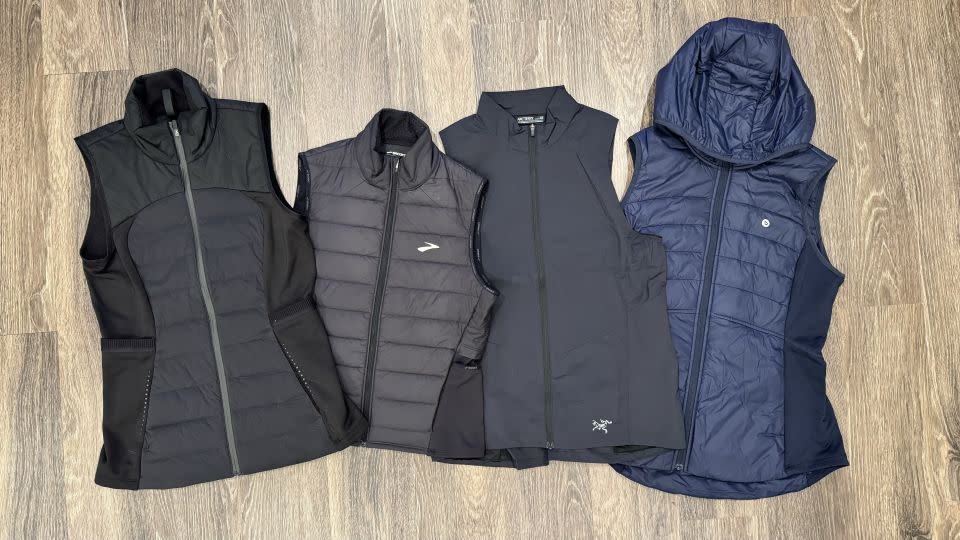
There’s no such thing as bad running weather, only bad gear, or so goes an old adage that’s been co-opted to justify working out in extreme conditions. What we do know for sure is that the colder the weather, the more layers you need. But finding the right balance between too much and too little can be difficult, and that’s where winter running vests come in.
A winter running vest, generally recommended when the temperature drops below 45 degrees Fahrenheit, is designed to keep your core (read: your vital organs) warm without compromising mobility. It can also block wind, rain, sleet and snow while still allowing for airflow and breathability so you don’t overheat.
This is a key layering piece and a versatile piece of apparel for any runner’s wardrobe. To that end, we logged over 100 miles in a number of highly recommended winter running vests over the course of December and January (and even during the Arctic blast that swept through most of the country). Here are our top picks.
Lululemon Women's Down for It All Vest
Best winter running vest
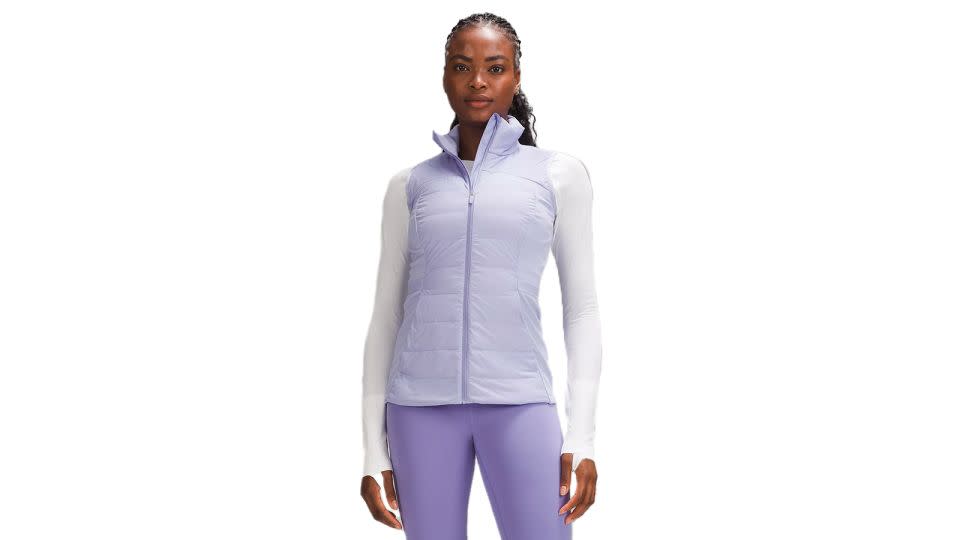
Lululemon’s puffy zip-up vest was the most highly recommended by other runners, and we found that it stood up to every winter weather scenario we put it through.
Brooks Women's Shield Hybrid Vest 2.0
Best winter running vest runner-up
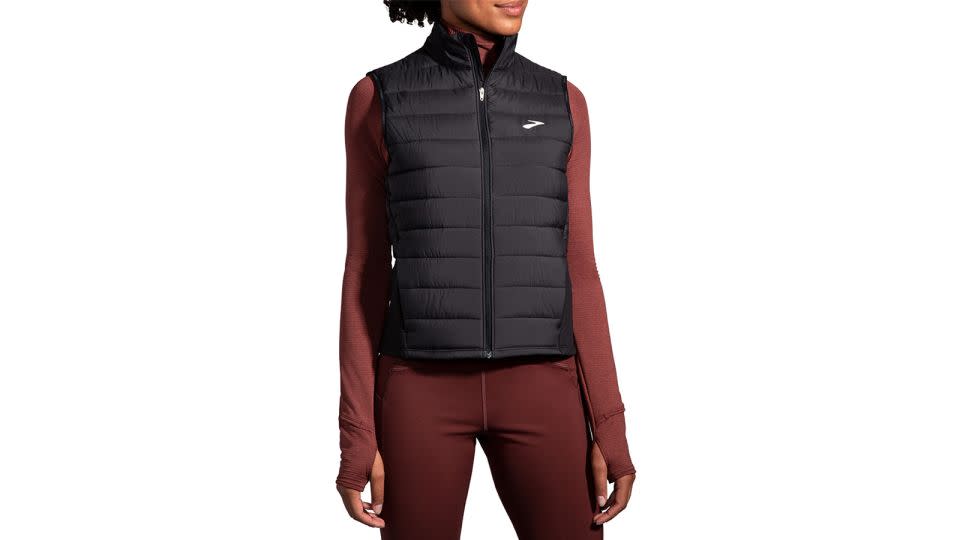
This versatile lightweight vest is toasty enough for the coldest runs but breathable enough to keep you from overheating if conditions warm up.
$120 at Brooks
$120 at Fleet Feet
$90 at REI
Arc'teryx Women's Norvan Insulated Vest
Best lightweight winter running vest
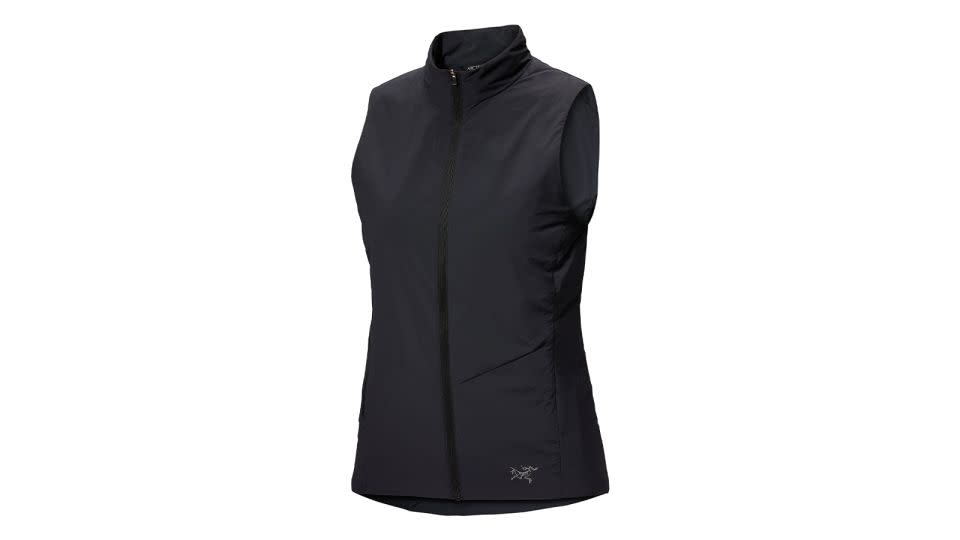
The Arc'teryx Norvan Insulated Vest is your best bet against wind chill due to its highly technical features and barely there feel.
Baleaf Women's Puffer Vest
Best budget winter running vest
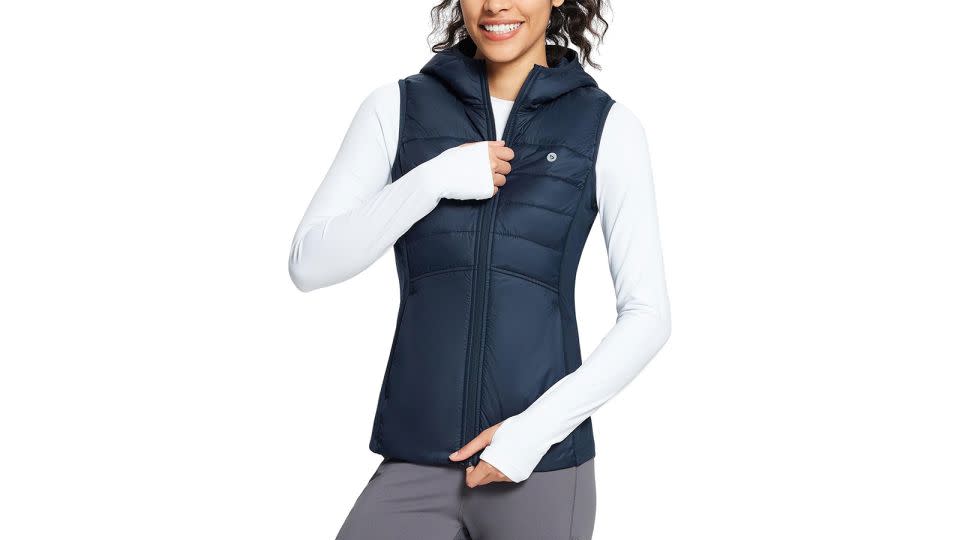
A more affordable alternative to the Lululemon, the Baleaf Women's Puffer Vest adds an oversized hood to further protect you from the elements.
Best winter running vest: Lululemon Women’s Down for It All Vest
$168 at Lululemon
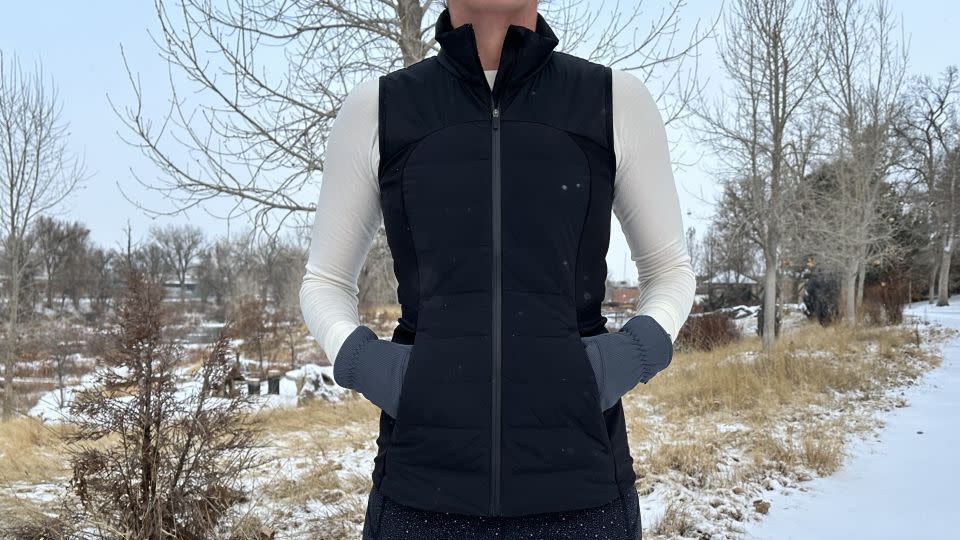
When we unofficially polled our running community about its favorite running vests, there was one recommendation that outnumbered the rest: the Lululemon Down for It All Vest. For starters, it’s one of the most aesthetically pleasing vests we tested. The slim, hip-length fit is almost universally flattering, with stretchy side panels that accommodate plenty of layers underneath.
The vest is built from a water-resistant, windproof Glyde fabric with zoned insulation panels to trap warmth where you need it without causing you to overheat. We wore this on all kinds of runs, and we didn’t find ourselves getting overly sweaty at any point, even on long ones in slightly warmer temperatures. There’s PrimaLoft insulation — a synthetic filling that’s not quite as warm as down — in the collar and shoulders, and the main body is filled with 700-fill-power goose down for warmth at your core.
Overall, it’s a surprisingly lightweight package that suited everything from short, easy runs in 6 degrees to longer workouts in the 30s. Our only complaint was some discomfort from the high collar rubbing our chin a bit, even though it’s made from a water-repellent tech fleece fabric that’s brushed for warmth.
The excellent storage options are another big selling point, with six pockets total: two interior pockets, two zippered exterior pockets and two side pockets. The side pockets were our go-tos because we were able to stuff our Apple iPhone 15 Pro Max, a GoPro with a selfie stick and multiple gels into each one without experiencing any distracting bouncing over the course of a 12-mile run. We found ourselves consistently reaching for this vest even when we weren’t testing it, which means it’ll for sure be a regular in our closet moving forward.
Best winter running vest runner-up: Brooks Shield Hybrid Vest 2.0
$120 $90 at REI or $120 at Brooks and Fleet Feet
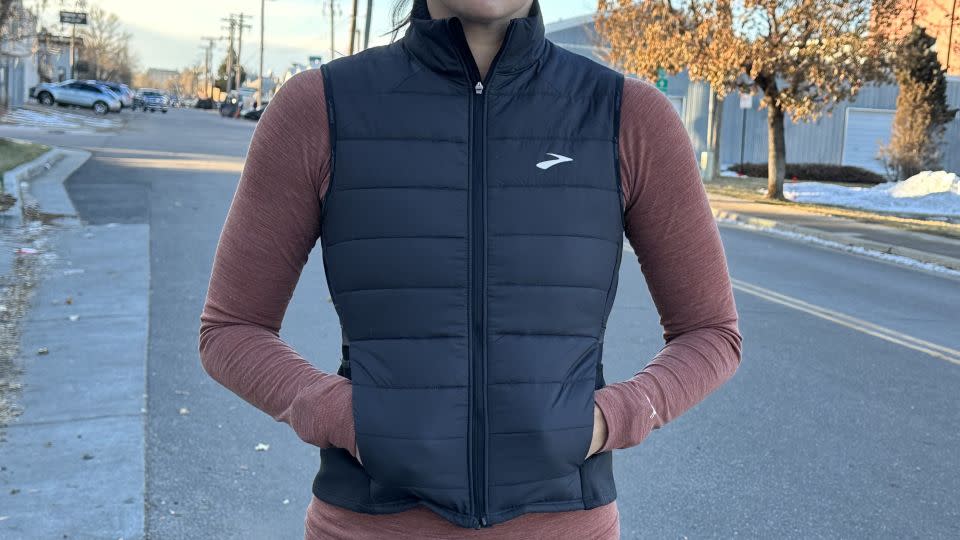
This has been our personal go-to running vest over the past two years, and we’re happy to confirm that it still stands up against competitors. Based on one of the brand’s most popular jackets, Brooks essentially cut off the sleeves and turned it into a layering component, but its versatility is the main reason this has been one of our longtime favorites.
The Shield Hybrid Vest is equipped with targeted wind protection to keep gusts from cutting through the fabric, and it uses the brand’s updated Thermolite insulation, which is 12% warmer than previous versions, to keep heat trapped close to your body without adding a ton of bulk. We’ve worn this vest in blizzards, in single-digit temperatures and even as a sleeveless top in the Palm Springs desert when we were warm enough to ditch our long-sleeve top underneath. And through it all, we still felt comfortable.
It’s also got a number of pockets that make it an excellent option for long runs. There are two drop-in side pockets, two hand pockets and a zip-secure chest pocket. We usually stash our keys and cards in the chest pocket, and use the drop-in side pockets for our phone, sports gels and GoPro. These pockets aren’t quite as deep as the ones you’ll find on the Lululemon vest, but they’re also a little less stretchy, which translates to less bouncing over the course of our runs.
Best lightweight winter running vest: Arc’teryx Norvan Insulated Vest
$180 at Arc’teryx or $180 $126 REI
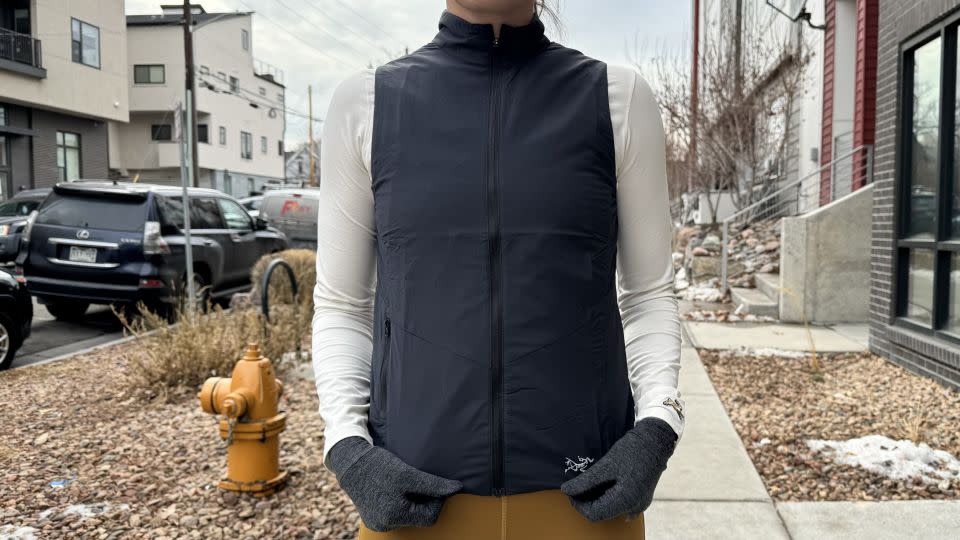
The best kind of running vest is the one you barely notice you’re wearing. The Arc’teryx Norvan Insulated Vest weighs in at just 90 grams, or about the weight of four AA batteries, and it was the lightest vest we tested. But it wasn’t just the number on the scale that made this lightweight option stand out.
Arc’teryx constructed the Norvan vest from super-technical materials, such as a durable external layer that provides warmth via synthetic insulation and blocks weather while still allowing for airflow as you sweat. Honestly, you can hardly tell this vest is insulated at all from looking at it, but you’ll certainly feel it when that wind starts cutting through anywhere not protected by it. We wore it on a slightly warmer day (the temperature was in the low 40s) with significant wind and could quickly tell how much colder our arms got than our core.
There’s only one pocket, which isn’t particularly useful for anything beyond a house key or credit card, although there was enough room to tuck in our gloves when we warmed up a bit; anything more would weigh down this vest, so we opted to keep our phone in our legging pocket. (Fun fact: The entire thing actually folds up into its own pocket!) That lack of excessive storage actually played into how much we liked the sleek and low-profile nature of this vest. Even though it did a great job keeping us warm and blocking the wind, it felt as if we were wearing nothing at all.
Best budget winter running vest: Baleaf Women’s Puffer Vest
$46 at Amazon
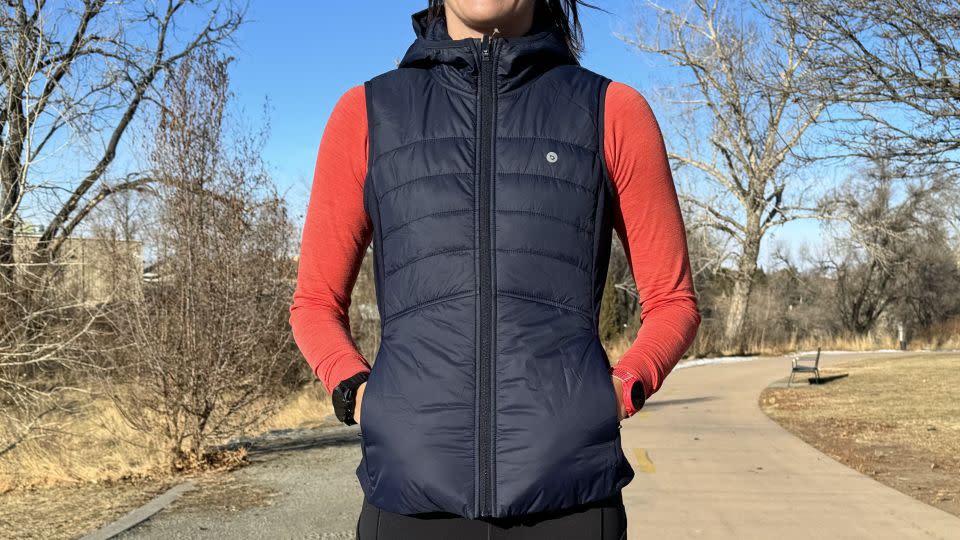
Lululemon’s price tags can be prohibitive for some runners, and that’s OK; the Baleaf Women’s Puffer Vest is a more affordable option that offers a number of the same benefits, proving you don’t need to spend a ton of money in order to get quality outdoor gear.
While it isn’t stuffed with down, Baleaf uses a high-performance thermal fabric called DuPont Sorona, a water-resistant form of polyester, to provide warmth in the cold. The design is very similar to the Lululemon Down for it All vest’s design; it’s got the same look of zoned insulation, with spandex side panels and elastic arm bands for comfort when adding on top of other layers.
We’d recommend sizing down in this one if you prefer a more fitted vest; we ordered a small, our normal size, and that lack of snugness did make us feel a little colder than we would have preferred while running in zero degrees, which felt like minus 7 due to the wind chill.
What we really loved about this vest was its hood. We didn’t see too many running vests on the market that even offered this feature. And Baleaf’s hood felt slightly oversized, coming down past the forehead and zipping up over the chin, which was especially helpful for blocking out wind and snow and keeping us warmer overall. The pockets, while not as numerous as on the Lululemon vest, were also deep enough to fit our phone, keys and gloves when we needed to take them off. For under $50, you can’t beat it.
What to consider when shopping for winter running vests
Materials
The weather outside will determine what vest is most appropriate. The coldest temperatures will warrant a vest with more insulation, such as the 700-fill-power goose down in the Lululemon Women’s Down for It All Vest or the Baleaf Women’s Puffer Vest’s DuPont Sorona thermal fabric. Down is best at trapping body heat and keeping it there, while synthetics aren’t as good at that but do allow for more breathability and airflow. If you’re expecting any kind of precipitation, you’ll want a vest with a water-resistant or -repellent treatment like you’ll find on the Smartwool Smartloft Vest. And if you’re mostly concerned about cold coming from wind chill, you may prefer a lighter vest with a windproof membrane like the On Running Weather Vest. Think about what weather is most common where you run, and buy accordingly.
Fit
Brands use different terms to describe how a vest might fit: semi-relaxed, regular, fitted and slim are all terms we saw on different sites. Generally, a slim or fitted vest is going to skim your body, giving you that next-to-skin feel that can provide added warmth. A semi-relaxed or regular fit will likely be a little roomier, which can be nice on days that aren’t super cold and you’re more concerned with protection from wind or water than you are from the temperature. If you do prefer a vest that has a more regular fit, you can always size down. Just make sure your range of motion isn’t restricted in any way.
Storage
One of the biggest perks of wearing a vest is more storage room while you run. That can be especially important on longer runs, during which you may want to shed accessories like hats or gloves but still need to carry essentials. We recommend opting for vests with deep side pockets, which eliminate more bouncing than the kind of standard front pockets you’d find on a jacket (see: the Lululemon Down for It All Vest versus the Outdoor Ventures Lightweight Soft-Shell Vest). In our opinion, the more pockets, the better, as they allow you to separate what you may need on the run — phone, gels — from additional things like car keys and ID so you can reduce the risk of dropping or losing anything.
How we tested
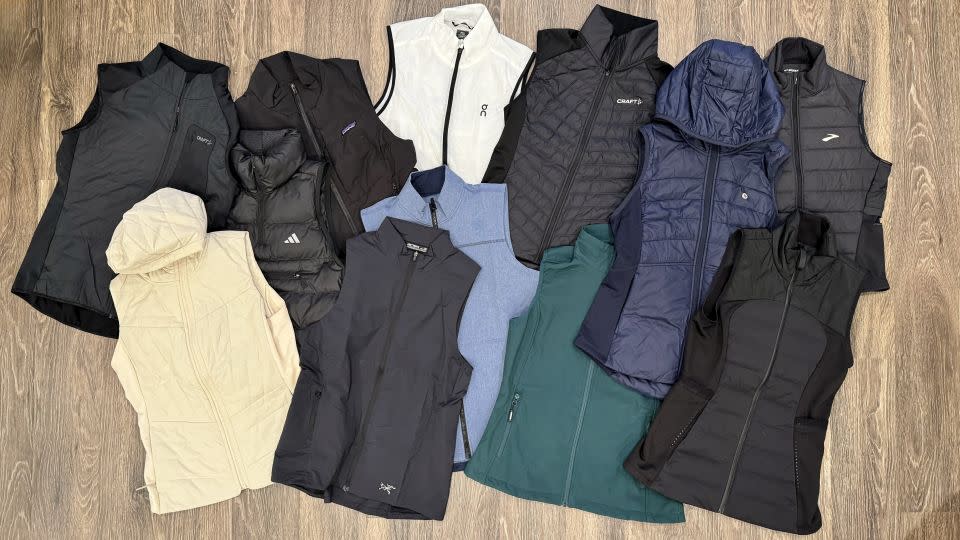
After selecting a number of winter running vests based on recommendations and competitor research, we picked 12 options worth trying. We ran with each one for at least 6 miles or one hour.
Running conditions
Weather: Since there’s no better way to test winter vests than to subject them to the worst running weather Colorado has to offer in December and January, we ran in snow, sleet and serious wind.
Fabric
Warmth: Were the vests stuffed with goose down, synthetics or a mixture of both?
Precipitation: Did the vests have a treatment that made it resistant or repellent to water?
Wind chill: Did the vests offer a windproof membrane?
Fit
Semi-relaxed or regular: Did the vests offer a roomier fit for more protection, which is better for wind and water than for warmth?
Slim or fitted: Did the vest have a body-skimming style for extra warmth?
Pockets
Side pockets or front pockets: What type of pockets did the vests have? If deep side pockets, did they tone down bouncing?
Number of pockets: How many pockets did each vest have? Did they help properly separate out personal items like keys from what you need to run, such as gels and your smartphone?
Other winter running vests we tested
Adidas Women’s Ultimate Conquer the Elements Warmer Vest
$100 $50 at REI
The Adidas Women’s Ultimate Conquer the Elements Warmer Vest was the only pullover vest we came across in our research, so we had to try it. It looks kind of silly — almost like a puffy version of the jersey you’d pull on for flag football — and we weren’t sure how we’d feel about the open sides. However, we liked the element of customization the adjustable straps gave this vest (we had to cinch it over a tank, a wool turtleneck and a zip-up), and the rest of it was so warm that even in minus 4 weather with a RealFeel of minus 21, we were totally cozy. It was also nice to have such an easily accessible, oversized pocket right at the chest so we didn’t have to fumble too much for our items while wearing gloves. Plus, our iPhone fit perfectly and a hook secured our car keys.
Smartwool Women’s Smartloft Vest
$185 $111 at Smartwool
Smartwool is one of our go-to winter running brands, due in large part to its liberal use of merino wool, which naturally helps regulate body temperature and is super comfy to wear. The hooded Smartloft Vest uses a proprietary mix of recycled wool insulation and a merino wool lining for lightweight warmth that traps heat even when wet. It also has a wind-resistant recycled nylon exterior with a durable water-repellent finish to further protect from the elements. On a 7-mile run at 9 below zero with a RealFeel of minus 21, we could definitely tell it was working hard to keep our core warm, especially in terms of blocking the wind, compared with how our arms felt in just our jacket sleeves, yet it didn’t feel bulky or make us break a sweat.
Rabbit Zip ’n’ Zoom Vest 2.0
$120 $84 at Rabbit
Rabbit says the Zip ’n’ Zoom Vest 2.0 is ideal for brisk, cold runs, and we’re inclined to agree, especially after overheating in the mid-30s. The durable exterior is tougher than most of the vests we tried — between the texture and the color, it has an almost denim vibe to it — and it’s coated with an eco-friendly water-repellent finish. (It’s wind-resistant as well.) The semi-relaxed fit isn’t exactly conducive to carrying a phone — ours bounced so much against our hip that we had to move it to our leggings — but we were able to stuff our headband and gloves in each zippered side pocket once the temperature started warming up.
Outdoor Ventures Women’s Lightweight Soft-Shell Vest
From $40 at Amazon
Another budget-friendly option, the Outdoor Ventures Women’s Lightweight Softshell Vest has over 1,200 5-star ratings on Amazon. With a wind- and water-resistant shell, lightweight fleece lining and regular fit that still allows for layering, it’s a solid option for moderately cold temperatures. We found it to be most comfortable for temperatures in the mid-20s without much wind. The higher collar has a drawstring designed to really block the elements when it’s fully zipped, and the drawcord at the hem can also be tightened to protect against wind and moisture. We’d also recommend sizing down in this one; although the product description claims it’s slim fit, we found it to be baggy enough that our phone kept banging against us while in the side pocket.
Craft Women’s ADV Essence Warm Vest
$110 at Craft
A streamlined take on the classic puffy vest, the Craft ADV Essence Warm Vest is designed for reaching full range of motion in colder weather. The Swedish company knows a thing or two about winter cardio, and it used quilted padding at the front and back to provide plenty of warmth and elastic jersey at the sides to ensure you can get that full arm swing with every step. We liked the “athletic,” aka slim, fit, which kept us warm in 27 degrees at the start of our run but didn’t make us overheat once the sun was fully out. It also kept our phone from bouncing in the one zippered pocket, though we wish both zipped, as there wasn’t much we could do with the open one while running, and we opted to keep our keys in our legging pocket for security. The brushed fabric at the collar that kept it from chafing at our chin was another nice touch.
Craft Women’s Core XC Ski Training Insulate Vest
$120 at Craft
Craft’s Core XC Ski Training Insulate Vest isn’t specifically designed for running, but cross-country skiing gear is excellent for any kind of winter cardio because of how well it blocks wind and retains heat. This vest is no exception. It has a lightly padded front, it uses three layers of wind- and waterproof fabric at the shoulders and sides, and it has a brushed fabric at the back not only for warmth but also enhanced ventilation and moisture transport. While we’d normally reserve these for even colder days, we tested it during a 10-mile workout that started in the low 20s, and when our friends got sweaty enough that they had to shed their extra layers, we still felt nice and comfy thanks to that built-in breathability.
Patagonia Women’s Nano-Air Light Vest
$199 at Patagonia
Comparable to the lightweight On Running and Arc’teryx vests, Patagonia’s Nano-Air Light Vest is barely noticeable. It’s slightly heavier than the Arc’teryx vest, and most of that extra heft comes from insulation; we could feel the added warmth on one snowy run. The shell is made from a breathable, stretchy ripstop fabric that’s coated with a durable water-repellent finish, and this kept us dry during an hour of snowfall. We really loved how soft the fabric felt. Even with it zipped up to our chin, we didn’t feel any uncomfortable rubbing or chafing from the collar. The streamlined fit kept our phone from bouncing in the side pockets, which were also roomy enough to fit our gloves, and we liked the addition of a smaller chest pocket for stashing our headphones and keys.
On Running Women’s Weather Vest
$190 at On Running
We were pretty torn between the Arc’teryx vest and the On Running Weather Vest when it came to the best lightweight option. On Running’s vest is almost as light at just 100 grams, and it has a tissue-thin feel despite its insulated front panel (it’s recommended as a middle layer). It was in the mid-20s when we tested this one, and although it did help us feel warmer, it didn’t feel quite as warm as some of the other vests we tested. Overall, we’d recommend this one for anyone who heats up easily and hates feeling constricted or wearing heavy layers, but it likely wouldn’t be helpful if you get cold easily.
Note: The prices above reflect the retailers' listed price at the time of publication.
For more CNN news and newsletters create an account at CNN.com

